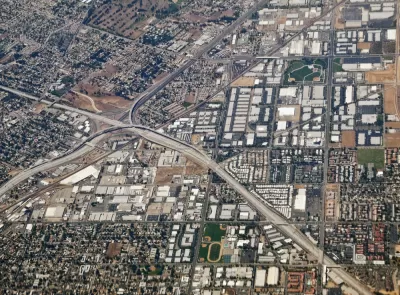The final version of a "Good Neighbor Policy" adopted by Riverside County in November fell short of the original author's intentions.

Paloma Esquival reports on the effort to approve a "Good Neighbor Policy" that would have required a buffer between large warehouses and residences in Riverside County in Southern California's Inland Empire Region.
The Riverside County Board of Supervisors recently approved the "Good Neighbor Policy," but with such significant changes that the policy's original backer voted no on the final produce.
Riverside County Supervisor Kevin Jeffries pushed for a policy that would have required a 1,000-foot buffer between warehouses and residential neighborhoods in response to a wave of construction in the region. "In the last decade, more than 150 million square feet of industrial space, the vast majority of it warehouses, has been built in the Inland Empire, according to real estate services company CBRE," writes Esquival.
“We blew it,” [Jeffires] said. “The standards that were adopted are really no standards at all.”
Regulatory constraints on industrial development in Riverside County proved unpopular, as critics of the idea cited the protections of the California Environmental Quality Act and the need for jobs in a region struck particularly hard by the effects of the Great Recession.
Among the concessions granted in the final, approved version of the Good Neighbor Policy: 1) individual supervisors retain the "ability to opt out of the policy in their districts, and 2) "instead of the 1,000-foot buffer that Jeffries had proposed, they adopted a 300-foot buffer, measured from warehouse loading docks to property lines," reports Esquival.
FULL STORY: Efforts to rein in the Inland Empire’s warehouse industry fall flat

Alabama: Trump Terminates Settlements for Black Communities Harmed By Raw Sewage
Trump deemed the landmark civil rights agreement “illegal DEI and environmental justice policy.”

Study: Maui’s Plan to Convert Vacation Rentals to Long-Term Housing Could Cause Nearly $1 Billion Economic Loss
The plan would reduce visitor accommodation by 25% resulting in 1,900 jobs lost.

Planetizen Federal Action Tracker
A weekly monitor of how Trump’s orders and actions are impacting planners and planning in America.

Wind Energy on the Rise Despite Federal Policy Reversal
The Trump administration is revoking federal support for renewable energy, but demand for new projects continues unabated.

Passengers Flock to Caltrain After Electrification
The new electric trains are running faster and more reliably, leading to strong ridership growth on the Bay Area rail system.

Texas Churches Rally Behind ‘Yes in God’s Back Yard’ Legislation
Religious leaders want the state to reduce zoning regulations to streamline leasing church-owned land to housing developers.
Urban Design for Planners 1: Software Tools
This six-course series explores essential urban design concepts using open source software and equips planners with the tools they need to participate fully in the urban design process.
Planning for Universal Design
Learn the tools for implementing Universal Design in planning regulations.
Caltrans
Smith Gee Studio
Institute for Housing and Urban Development Studies (IHS)
City of Grandview
Harvard GSD Executive Education
Toledo-Lucas County Plan Commissions
Salt Lake City
NYU Wagner Graduate School of Public Service





























